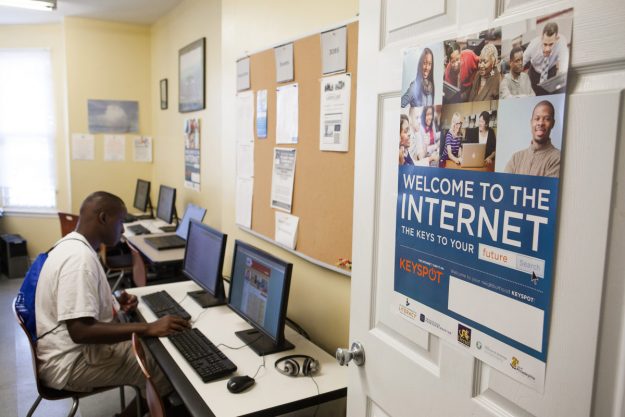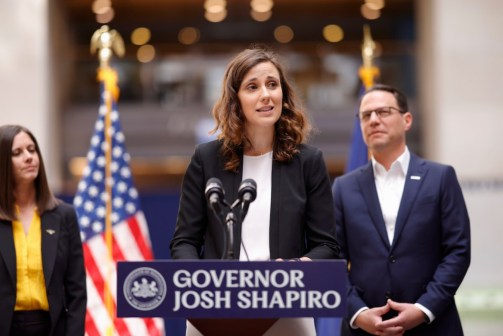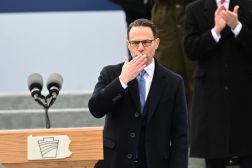Philadelphia’s digital literacy community readies second year of program grants

The digital divide is shrinking, but there are still about 35 million people in the U.S. who say they never go online. In Philadelphia, a growing network of community groups, businesses, nonprofits and public agencies are trying to put a bigger dent in that figure as it wraps up its first year of grants.
The Digital Literacy Alliance (DLA) was created to provide access to technology and educate members of public — particularly low-income and elderly populations — with the hope that it will make them lifelong internet users empowered with new social agency. But as organizers get ready to announce the second year of grantees in August, they’re learning that while a surplus of resources is a comfortable position, it doesn’t guarantee results — it’s going to take creative planning to reach their goals.
This year’s grant applicants will each compete for a piece of $175,000 in funding. Andrew Buss, the City of Philadelphia’s deputy chief information officer for innovation management and the program’s lead, describes the alliance as “a seed fund to generate innovation” in digital literacy. The organization’s finances got off to a solid start in 2016, with a $500,000 donation from Comcast and later $350,000 from Verizon — two corporations with an obvious interest in making sure people use the internet.
Pew Research Center found in 2011 that 24 percent of Philadelphians were offline, and in 2013 it saw that figure decline to 18 percent, a trajectory that put the city on par with the national internet adoption rate. But between a network of more than 50 public computing centers that was started in 2010 — called Keyspot — and the large number of community groups that were getting together to brainstorm on digital literacy in the city, Philadelphia has become in recent years something of a leader when it comes to helping people get online, Buss says. But despite the city’s enthusiasm for the issue, Buss also says something was missing.
“We needed that third slice — innovation — to try to do some experimentation and let some community groups try some new things and see where that goes to advance our learnings around digital literacy in Philadelphia,” he says. “There are still big challenges around that.”
Digital literacy is finding financial support — the Comcast Foundation granted $1.8 million to 49 nonprofits in Philadelphia, New Jersey and Delaware in 2016, including the $500,000 for the DLA — but inciting widespread behavioral change typically takes more than throwing money at a problem. While Philadelphia has yet to statistically prove the efficacy of its programs, the Digital Literacy Alliance has shown diligence and creativity in trying to reach people.
Last year, the alliance awarded more than $167,000 in grants to eight nonprofits, like a group called Generations On Line that partners with churches, housing developments, and senior organizations to provide seniors with tablet training sessions through what it calls “sip and swipe cafes.” Because they’re easy to use, Buss says, tablets are “gateway devices” for broader and sustained internet use by those who had perhaps never gone online before.
The first-year grantees were chosen via the alliance’s strategy to meet the community’s needs as those needs are described by the community itself. They also included a group called Mighty Writers that has journalists help teachers and students differentiate between different types of information online, and a group called VietLead that launched the “VDigiLab,” a technology center designed to close the digital literacy gap among Vietnamese Philadelphians who can be alienated by technology due to limited English proficiency.
Early on, says Eliza Pollack, the city’s assistant director of innovation strategy, all the projects were categorized using a top-down approach to assistance, but the program is now structured to allow the community more heavily dictate which populations and challenges should take priority.
“When you’re dealing with a landscape of so much need, but so much different need, putting all those labels on things ended up being way less helpful than we anticipated,” Pollack says. “It’s been a learning experience on our end to let the organizations tell us what kind of work they’re doing and what they need so we can then internalize that information and recognize, [for example, that] the immigrant populations in Philadelphia really need more support or maybe the schools need more support.”
The demographics of the digital divide aren’t always what people expect. Pew survey data has historically shown that while seniors are the group most likely to report that they never go online (and that is likewise reflected in the nonprofit’s 2017 data ), ethnic background has consistently proven a non-factor, regardless of the age or income bracket examined. Access across white, black and Hispanic populations is comparable, according to Pew data. (Pew doesn’t assess Asian populations because it says there aren’t enough respondents in its surveys to provide a representative sample.)
And while the gap is tightening each year, particularly among low-income populations where lack of access is most common, Buss says the broad statistics don’t tell the full story. Often those who report having internet access only have access using a mobile device, and a young person with a smartphone doesn’t necessarily glean the same benefit from being online as someone with a computer who can write a resume or use more sophisticated services not available on mobile devices.
On the adoption side, Buss said, generational issues are the biggest challenge — older people sometimes don’t feel comfortable with mobile devices, and younger people may only want to use mobile devices.
The alliance’s members each play a role in addressing those types of challenges — big telecommunications companies like Comcast and Verizon provide the capital, government organizations like the Mayor’s Policy Office and the Office of Adult Education organize and facilitate programs, while universities like Penn, Temple and Drexel provide expertise, and community groups like The Welcoming Center and the Media Mobilizing Project run the programs and provide a bridge to the populations the funding is meant to serve.
When the next round of grantees is announced in August, Buss said, the alliance will hold a “learning session” that allows participants to share things they’ve learned, challenges, and ideas on how to sustain programs. The grants will also be divided into two groups this year — innovation grants will be awarded for new ideas and sustainability grants will support existing programs.
The biggest challenge in addressing the digital divide in Philadelphia, Buss said, has been taking all these resources and converting them into substantive change. The funding is there. The facilities are open. People are willing and ready to help. Now, Buss said, it’s time to advance the program and get everyone online.
“We have a lot of centers now,” he said. “How do we start to drive the number down for people who don’t have internet access?”






